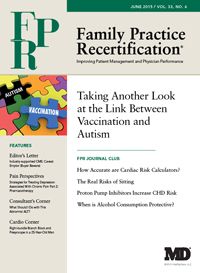Publication
Article
PCSK9 Inhibitors: Newer Does Not Always Mean Better
Author(s):
With much fanfare earlier this month, the Endocrinologic and Metabolic Drugs Advisory Committee of the Food and Drug Administration endorsed approval of 2 new highly-anticipated, injectable agents for lowering cholesterol, alirocumab and evolocumab. Although the FDA is not obliged to follow these recommendations, it is a only a matter of time before these two proprotein convertase subtilisin kexin 9 inhibitors will be available by prescription in the United States.

With much fanfare earlier this month, the Endocrinologic and Metabolic Drugs Advisory Committee (EMDAC) of the Food and Drug Administration (FDA) endorsed approval of 2 new highly-anticipated, injectable agents for lowering cholesterol, alirocumab (Praluent®) and evolocumab (Repathia®). Although the FDA is not obliged to follow these recommendations, it is a only a matter of time before these two proprotein convertase subtilisin kexin 9 (PCSK9) inhibitors will be available by prescription in the United States.
udies indicate these new agents can lower LDL-C by 40-60%, a figure exceeding the 30-50% reduction achievable with statin therapy. Waiting in the wings is a third PCSK9 inhibitor, bococizumab.
Why the excitement surrounding PCSK9 inhibitors? From an industry perspective, the answer is straightforward: according to the Centers for Disease Control, 73 million Americans have elevated LDL-C levels putting them at higher risk for cardiovascular disease and the price tag for these agents has been estimated at $7,000 to $12,000 per year. From a medical perspective, the answer lies in recognition that statin therapy is not the “be all, end all” solution hoped for.
First of all, many patients have difficulty tolerating statins with 5 to 10% of patients discontinuing treatment because of side effects. In addition, among patients who tolerate a statin, side effects may preclude them from taking the dose optimal for lowering cardiovascular risk. Finally, even in patients in whom a maximum dosage of statin therapy is tolerated, target LDL-C levels are not achieved in more than half of patients with familial hypercholesterolemia and an increased residual cardiovascular risk still persists, particularly in high-risk subjects, for example acute coronary syndromes.
Should these agents replace statin therapy? The short answer is a resounding “no”. Since their introduction more than 3 decades ago, statin therapies have proven to be one of the most effective and safe pharmaceutical agents ever developed. Although PCSK9 inhibitors appear more effective at lowering LDL-C, there is insufficient proof at this time to know whether these agents will prove as effective as statins in the primary and secondary prevention of coronary heart disease and stroke.
In addition, unlike statin therapy, the short- and long-term side effect profile for PCSK-9 inhibitors remains uncertain. In addition to injection site reactions and flu-like symptoms, neurocognitive cognitive issues (including memory loss, difficulty concentrating, and confusion), liver issues, and risk of diabetes are possible areas of concern raised by early studies as well.
History warns us that the lowering of surrogate markers (such as LDL-C) by a drug does not necessarily translate into improved outcomes. For recent examples of drugs improving biomarkers without producing the intended outcomes, one needs to look no farther back than menopause hormone therapy, torcetrapib, and niacin.
The FOURIER (Further Cardiovascular Outcomes Research with PCSK9 Inhibition in Subjects with Elevated Risk) study and ODYSSEY study are ongoing clinical trials expressly designed to provide needed outcomes-based data but their findings will not be available for another 2 to 3 years. In the interim, following FDA approval, it would be prudent to limit use of PCSK9 inhibitors to subjects with familial hypercholesterolemia and secondary prevention in selected high-risk patients unable to tolerate statins or with suboptimal LDL-C blood levels despite statin therapy. Until clinical outcomes and long-term safety data becomes available, use of these agents for primary prevention would be premature. Although promising, it would be prudent to use these agents with caution initially and not lose sight of the fact that “newer doesn’t always mean better”.
PCSK9 inhibitors are monoclonal antibodies, which work by inhibiting an enzyme involved in the degradation of the hepatic low-density lipoprotein (LDL) receptors responsible for removing LDL cholesterol (LDL-C) from the circulation. By blocking this enzyme, PCSK9 inhibitors enhance the clearance of LDL-C from the bloodstream and have proved to be powerful agents for lowering LDL-C levels. St






